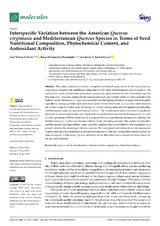Interspecific Variation between the American Quercus virginiana and Mediterranean Quercus Species in Terms of Seed Nutritional Composition, Phytochemical Content, and Antioxidant Activity
Autor
Valero-Galván, José
González-Fernández, Raquel
Jorrin Novo, J.V.
Editor
MDPIFecha
2021Materia
Quercus seeds morphometryChemical seeds composition
Clustering analysis
METS:
Mostrar el registro METSPREMIS:
Mostrar el registro PREMISMetadatos
Mostrar el registro completo del ítemResumen
This study aimed to evaluate a complete nutritional composition in the seeds Quercus virginiana to compare this nutritional composition with three Mediterranean Quercus species. We analyzed the seed morphometry, proximate composition, phytochemicals, and antioxidant capacity. The seed of Q. virginiana presented the smaller seed size and weight, while Q. suber presented the highest values. Moreover, Q. virginiana seeds showed the highest amounts of sugar and total lipids, digestibility, energy, palmitic acid, and stearic acid. On the other hand, Q. virginiana seeds showed the lowest values of linoleic acid. Moreover, Q. coccifera seeds presented the highest total phenolics and flavonoids contents and antioxidant activity. The clustering analysis revealed a significant similarity in seed morphometry and nutritional composition between the Mediterranean Q. ilex and Q. suber, grouping with the American Q. virginiana, but to a considerable distance; by contrast, the Mediterranean Q. coccifera was the most distant in the clustering analysis. The content of phenolics and flavonoids and digestibility value were the variables that contributed to the separation to a greater extent in the clustering of the four species. The nutritional and biological activity assessment of plant seed may be considered as an essential mission to find new sustainable sources and novel chemical agents. In this sense, Quercus seeds may be an alternative and a competitive food source for the agri-food industry.

